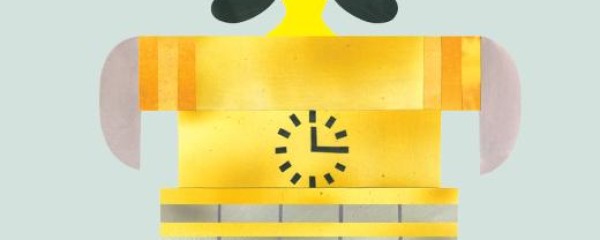Digging Jurassic Dinosaurs in Wyoming: ‘Camarasaurus’ Morris
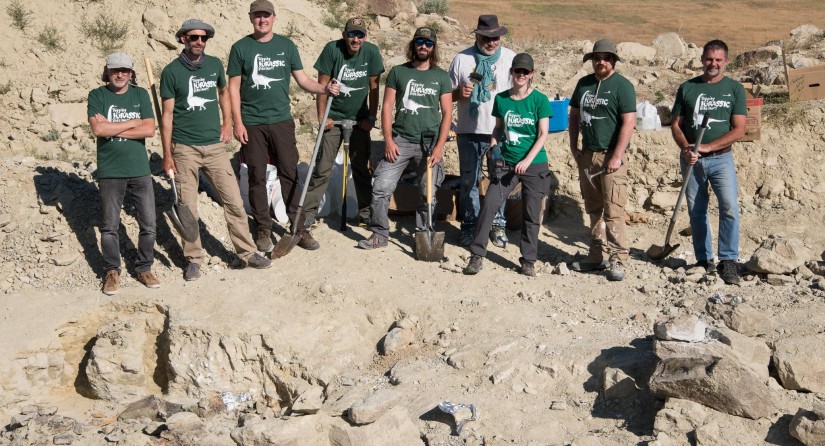
The third excavation season in central Wyoming is a spendid one for the Institute of Natural Sciences: three dinosaurs from the late Jurassic era. A - at first sight - young Camarasaurus, a Dryosaurus and possibly a Brachiosaurus. After a full summer of digging, chiselling and plastering, the first two are ready to be shipped to Brussels. There, we will prepare them, scan them, study them and mount them.
Watch all vlogs from Wyoming.
‘This is the adolescent,' grins Belgian palaeontologist and expedition leader Pascal Godefroit as he shows us around on Pine Pit. He and his three colleagues from the Institute of Natural Sciences (RBINS) have already unearthed about half of a young Camarasaurus - 10 to 12 metres long - in one month and named it 'Morris'.
It's up to the five-man relief team, of which I am a member, to cut, grind, chisel, scratch, brush, plaster and hoist from the site another hundred or so fossils of this long-necked dinosaur with typically spoon-shaped teeth.
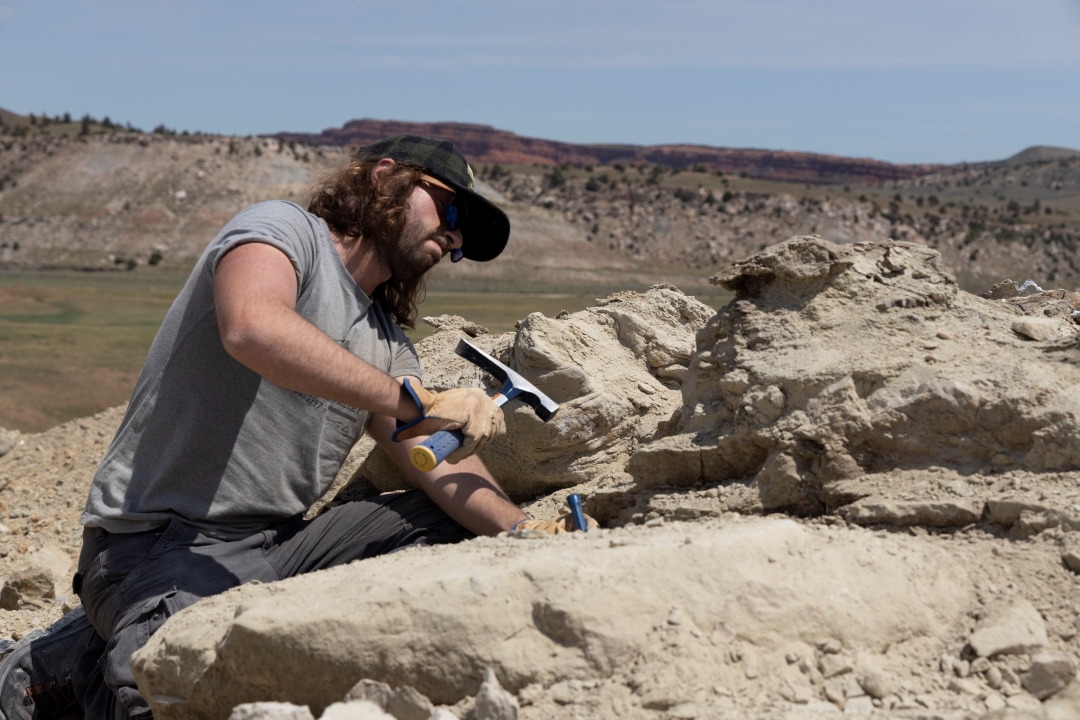
To the left of this young sauropod is a specimen resembling a Dryosaurus, a small ornithopod dinosaur and a early ancestor of our Belgian iguanodons of Bernissart. On the right-hand side of the site is a brachiosaurid dinosaur. Brachiosaurs were one of the biggest land animals ever: more than 20 metres long, four storeys high, weighing about 30 tonnes and defying the limits of what evolution is capable of. The pubis, shoulder blade and vertebrae that we have already been able to uncover are indeed huge and very well preserved. Next season, we will need a lot of hands, that much is clear.
The rock-hard siltstone and the grainy sandstone above it are the win-for-lifes in which we can scratch away fossils. An addictive activity.
We are in the world-famous Morrison Formation, a geological stratum with waves of small hills in beige, grey and red. The formation is found in thirteen American states, but mainly in Wyoming and Colorado. The layer we are excavating in dates from about 150 to 155 million years ago (the Kimmeridgian), the end of the Jurassic era. Morrison was formed by the many small rivers that flowed from the precursors of the Rocky Mountains, carrying silt and sand.
From our hilltop - it looks like a mini-volcano crater - I try to picture it: herds of long-necks of various shapes and sizes moving slowly across a plain covered with conifers, araucarias, ginkgo, horsetails and ferns. They cross the many streams and lakes on their way to a fresher piece of vegetation.
This was a flood plain. In the event of a sudden flood, some of the animals that had died just before or were taken by surprise by the force of nature must have been quickly covered by sediment and then fossilized. The soft grey clay layer that we pick at with an oyster knife is that ancient riverbed. The rock-hard siltstone and the grainy sandstone above it are the win-for-lifes in which we can scratch away fossils. An addictive activity.
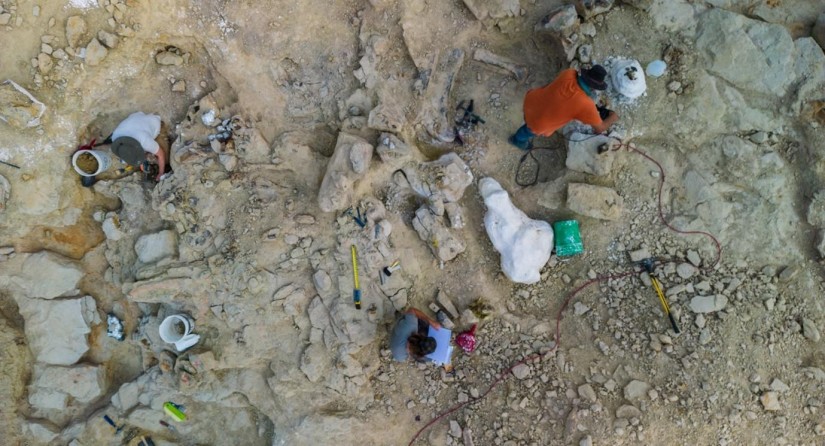
Investment
Fossils are also increasingly the winning scratch-offs of the commercial market and investors. A small German company we work with has been active in and around the Powder River Basin for twenty years. These bona fide fossil hunters make an agreement with a ranch owner to excavate on his property during the summer. The US is one of the few countries where this is still possible and allowed.
They hope that the digging will yield something saleable. Carnivorous dinosaurs are especially popular. ‘I hold the world record for digging up allosaurs: eight,' says one of the Germans, always dressed in a brown hat, a checked shirt, shorts and white stockings. We rely on their reconnaissance work.
It all started near a juniper tree. There the fossil hunters found an Allosaurus - the 'T. rex of the Jurassic era' - almost completely blown free by erosion. A few summers later, diplodocine 'Dan' followed, which will be prepared for the Dinosaur Gallery of the Institute of Natural Sciences in the next two years. Then there was another Allosaurus, which has now ended up in South Korea. Then came an Apatosaurus. This year, they can add another small carnivore and pieces of a Diplodocus-like dinosaur to the list.
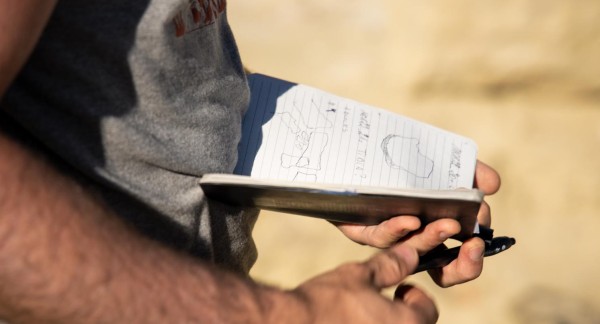
Pine Pit, at the base of a pine tree, also has an impressive track record: in 2014 Allosaurus 'Arkhane', bought by a private owner and on display in the museum’s Evolution Gallery since 2019. Just below it was an adult Camarasaurus. And now, in season 2022, we are at the layer where the 'adolescent Camarasaurus', the 'Dryosaurus' and the 'Brachiosaurus' lie. A little further on is another small carnivore. Are you following? It is a palaeontological Eldorado.
The long-necked dinosaurs of the Jurassic period illustrate the great heyday of the dinosaurs.
Every skeleton that has been unearthed here is very complete, and the quality of the fossils is exceptionally good. It gives us the chance to reconstruct the anatomy, evolution, species diversity in an ecosystem of 155 million years ago. And very possibly the cause of death. Were these animals swept away by the same flood and did the skeletons get stuck in a bend of a river? Or were they previously attacked by the fearsome predators Allosaurus or Ceratosaurus? We are left to guess.
Highlight
The dark bones of Morris that pass through our hands are the petrified witnesses to an unseen heyday in the 170 million years or so that dinosaurs populated the earth - not counting today's dinosaurs, the birds.
Dinosaurs, the group of land reptiles with legs under the body rather than next to it, arose in the Late Triassic, about 230 million years ago. That is the age of the red rocks that we see so beautifully lit at sunset and that have been the background for many western movies.
At that time, the continents were still locked together in one block - Pangea - and the climate was hot and dry. It was in this context that the first dinosaurs appeared. In about twenty million years, they gently diversified, but it were the Pseudosuchia, a large group to which today's crocodiles belong, that ruled the land in the Late Triassic. And yet this group was hit hard during the mass extinction at the Triassic-Jurassic boundary 201 million years ago. Only the line of crocodiles, then still a small group, survives, and the Pseudosuchia soon give up their leading position to… the dinosaurs.
Within 10 million years - we are now in the Jurassic - they become incontournable, with an unprecedented number of different species. They also grow larger and spread over many more habitats.
Sauropods, the pot-bellied long-necks with their pillars of legs and ludicrously small heads and a comb-like dentary, best illustrate this period of prosperity. They are descended from smaller Triassic long-necks, prosauropods such as Plateosaurus, which still walked on two legs. Here in Europe, these plateosaurs were as common as cows today. In Switzerland, among other places, you find plenty of plateosaur fossils. One, named 'Ben', is on display in the Institute of Natural Sciences.
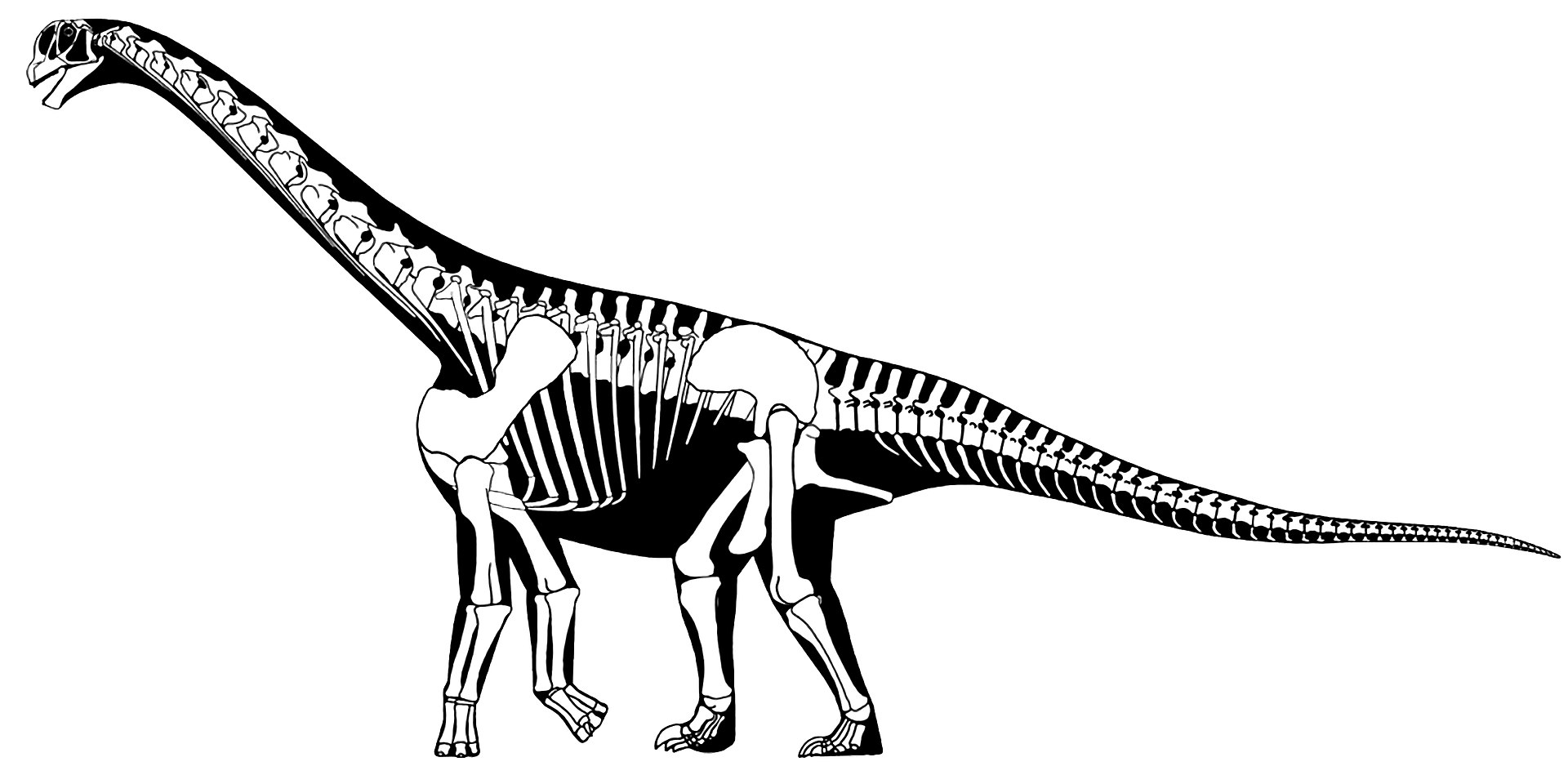
But what was the anatomical success formula of these outsized animals such as Brontosaurus, Brachiosaurus and others? What are the evolutionary trumps that enabled sauropods to last so long, until the end of the Cretaceous period 66 million years ago?
The answer: three adaptations. With their long necks, they could swallow enormous quantities of foliage without moving a step. They also grew rapidly. From hamster-sized offspring, they grew to super giants the size of an airplane in 30 years.
And, third success factor: sauropods had developed a very efficient breathing system. Many bones of the neck, chest and tail contained cavities in which air sacs were located. These pockets filled up when breathing in. When breathing out, the air in all these sacs flowed into the lungs. So they worked like a bellows: more oxygen to keep the metabolism of that mega body going.
I am reminded of this when I am digging a trench around a vertebra with palaeotechnician Karim Ben Larbi. It is very heavy as a fossilized bone, but with all those cavities it must have been quite light when the animal was alive.
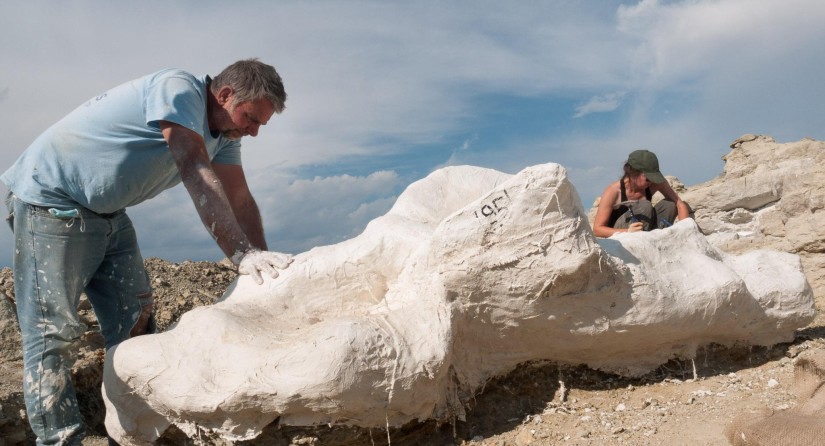
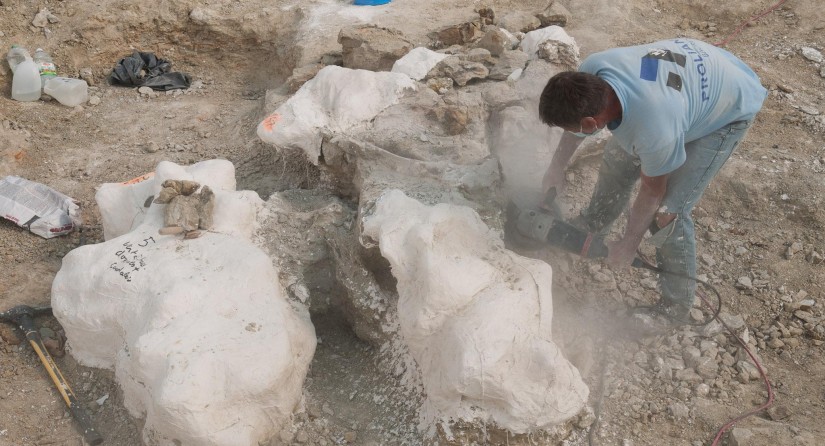
Litres of superglue
Anyone who has ever dreamed of excavating: yes, it is a dream. But in Wyoming, you have to put up with the heat - almost every day around 40 degrees Celsius above the reflecting pale sandstone. And the uncomfortable positions. I am not the most flexible person, so squatting on top of 'the pizza' - a large round block with all kinds of 'ingredients', from ribs to shoulder blades to the skull - for two hours and doing the same repetitive movements is a real work-out.
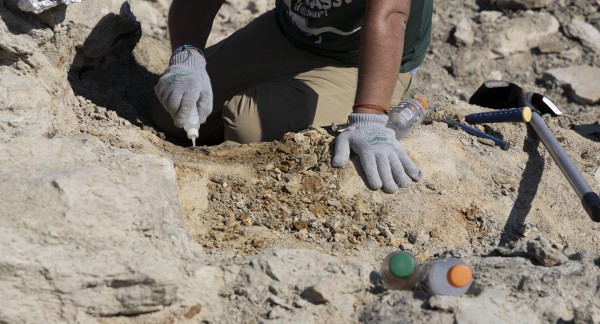
You also have to be careful not to kick away a piece of rib with those clunky mountain boots. And with the superglue - of which we pour several litres a week on exposed fossils to strengthen them - one must always be careful. In a moment of inattention, I let a good splash run over my glove, causing my fingers to burn and stick to the inside. Fortunately, I could immediately get a second skin in the bucket of plaster we were preparing to wrap in a femur.
This plaster method has not changed since the 19th century. It was perfected when the thirty or so skeletons of the Bernissart iguanodons were pulled out of the coal mine between 1878 and 1881. Without a protective layer of plaster, the precious fossils crumbled due to the gold-coloured mineral pyrite that is hidden in the iguanodon bones and expands like a tumour under the influence of air and moisture. Moreover, gypsum, jute and water are available everywhere in the world, even in the most desolate regions.
The year that miners in Bernissart made a world-class discovery, was also a boom year in Wyoming and Colorado: for the first time, complete and coherent skeletons of large dinosaurs were unearthed.
For years, two rival American palaeontologists, Edward Drinker Cope and Othniel Charles Marsh, had been paying teams of fossil hunters to send in as many bones as possible. The teams spied on and sabotaged each other. In a ludicrous publication race, the two archenemies described the fastest and the most species - often the same animals under different names. The result was a taxonomic mess. But it did mark the birth of the iconic dinosaurs of the Jurassic era, from Apatosaurus to Allosaurus to Stegosaurus.
Camarasaurus is so far the most frequently found dinosaur in the Morrison, and thus the best known. The fact that we have before us an almost complete, beautifully preserved and young specimen makes it still very special.
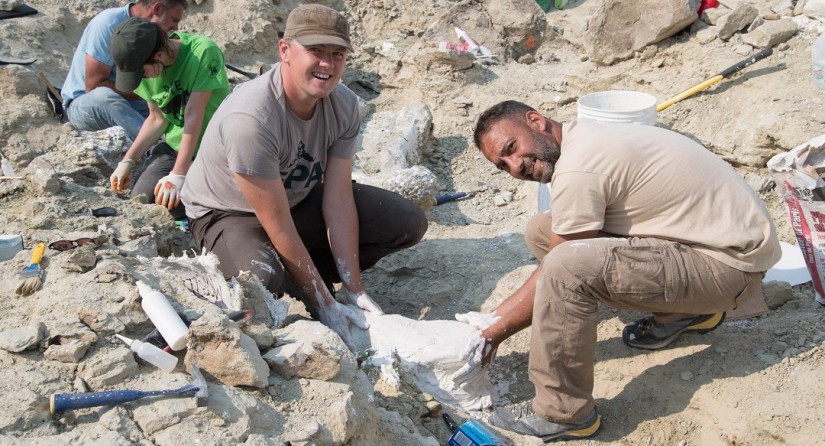
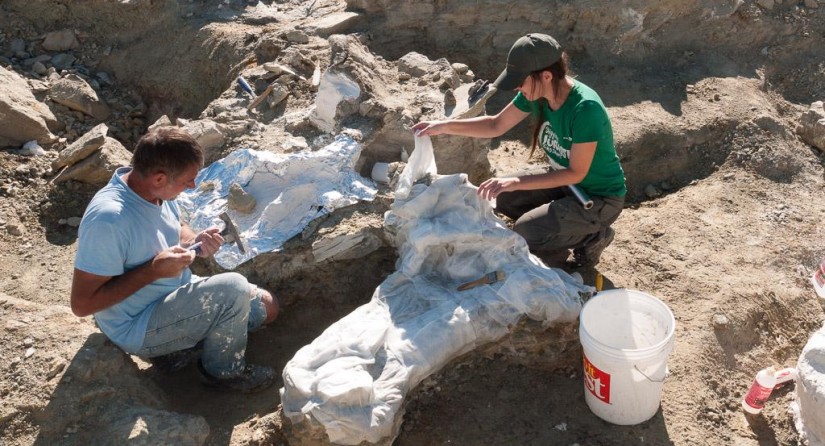
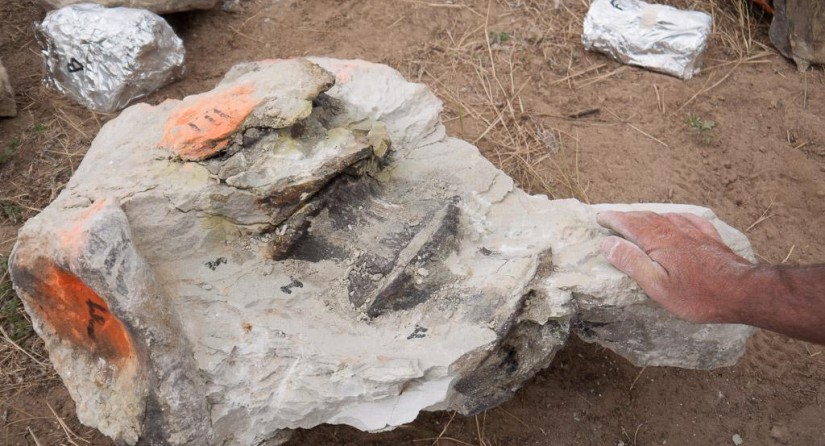
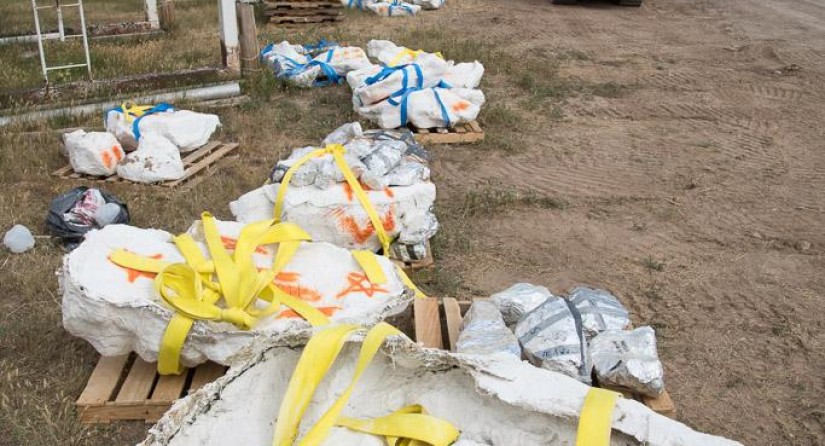
Humming above the site
The site is divided into three parts: first you have ‘the pizza’, where Morris' entire upper body lies. A little further on, there are two femurs. And closer to the edge of the hill, the rest of the lower body came to the surface: the pelvic girdle and all the bones that connect to it (watch our vlog with paleo engineer Xavier Valentin), also the tibia and fibula, the foot bones and - yes - the claws. Camarasaurus had three hefty claws on its hind legs and one on its front legs.
How do you keep an overview in the tangle of half-and-half superimposed pieces? Each parcel and each block of fossils is given a number and is briefly described in a notebook: 'MOR22 - 11, 12, 13', for example, are three ribs that we found on the side of the pizza. Team 1 also made an overview drawing of the site. We have archaeologist Aurore Mathys in the team, who makes high-resolution photographs of the site with her drone every two days (watch the video). This is how we reconstruct the progress of the excavations, determine the exact position of the bones, and make a 3D model of the site.
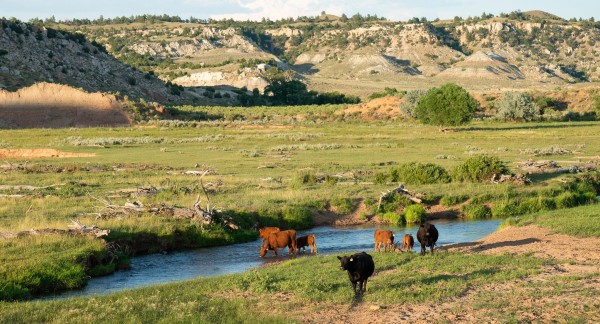
When I see the hills of the Powder River Basin getting smaller in the rear-view mirror, I have a hard time. I have grown fond of that never-ending scenery. For the locals in the least populated state of the US, this is a daily oasis that they drive through with their pickup trucks and quads. They live off hay and cattle. The simple life between family, church, hunting, fishing and rodeo.
‘Stress is something we threw away a long time ago,' said one of the three sheriffs I bumped into. He lives six miles from his closest neighbour. Is there a link between geology and peace of mind? Excavations make you zoom out, teach you to think in dizzying time scales, and put your own worries - and ultimately yourself as a human being - into perspective.
The team of season 2022 consisted of:
Pascal Godefroit (RBINS paleontologist), Mathys Rotonda (biologist), Filippo Bertozzo (RBINS paleontologist), Stijn Pardon (RBINS graphic artist and videographer), Xavier Valentin (University of Poitiers paleo-engineer), Karim Ben Larbi (paleotechnician with Raphus), Aurore Mathys (RBINS archaeologist), Thierry Hubin (RBINS photographer) and Reinout Verbeke (RBINS science communicator).



